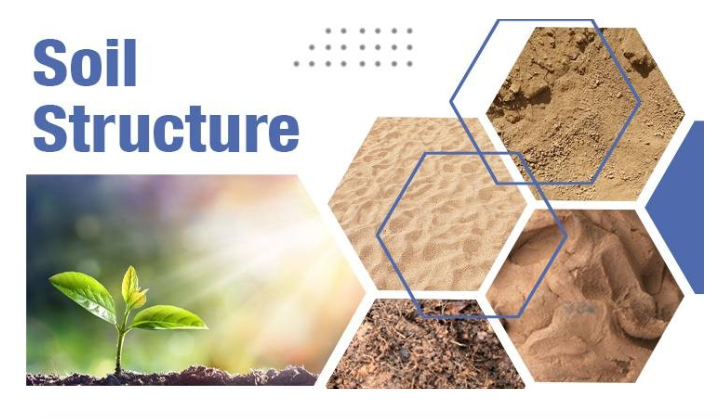
Soil structure is the degree and type of aggregation and the nature of pores and pore space. An aggregate possesses solids and pore space and are separated by planes of weakness and are dominated by clay particles. Some soils individual particles exist as discrete entities. While some other soils, the particles are arranged in groups with distinct shapes and sizes called aggregates. These aggregates are called peds. Some soils form good aggregates or where the soil is composed of only sands, the individual units may make few contact but with continuous pore phase. While in massive soils, the mineral material form the continuum with lots of discrete pores.
Structure is one of the defining characteristics of a soil horizon. A soil exhibits only one structure per soil horizon, but different horizons within a soil may exhibit different structures.
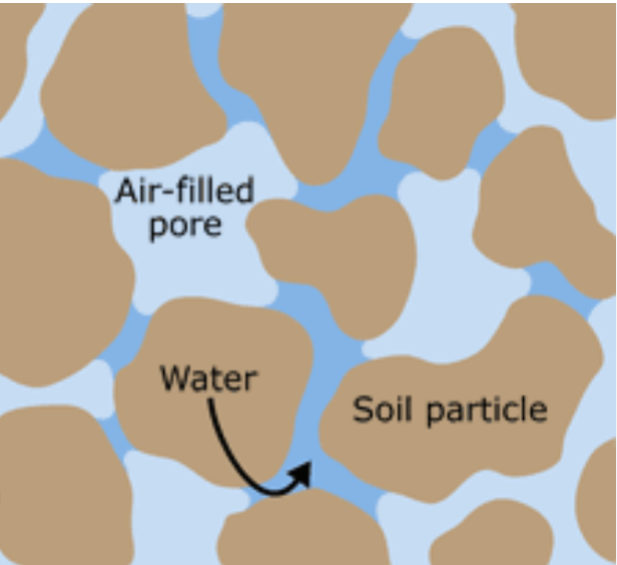
DESCRIPTION OF SOIL STRUCTURE
Soil structure is mostly described in terms of grade (degree of aggregation), class (average size) and type of aggregates (form). The form/shape, size, and degree/strength of aggregates determine pore structure, and how easily air, water, and roots move through the soil.
In some soils, different kinds of aggregates may be found together and are described separately.
GRADES OF SOIL STRUCTURE
The grade of soil structure is the degree of aggregation. It expresses the differences between cohesion within aggregates and adhesion between aggregates. Both properties ( that is, cohesion and adhesion) vary with the soil moisture content. Grade of structure is determined when the soil is neither moist nor dry. There are four major grades of structure rated from 0 to 3 as follows:
a. GRADE 0 : This is also refer to as Structureless soil. It has no observable aggregation or no definite orderly arrangement of natural lines of weakness.That is, the soils lack structure. When structureless soils are ruptured, soil fragments, single grains, or both may result. There are two categories of 0-grade soil structure:
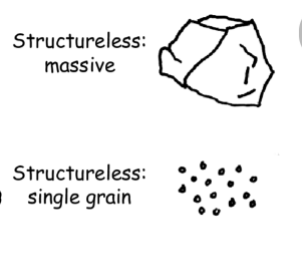
i. MASSIVE STRUCTURE (COHERENT ) : The entire soil horizon appears cemented in one great mass. They tend to form fragments when disturbed.
ii. SINGLE-GRAIN STRUCTURE (NON-COHERENT ) : The individual soil particles show no tendency to cling together, and are loose. They include pure sand.
b. GRADE 1: This has Weak structure. It is poorly formed from indistinct aggregates that can barely be observed in place. When removed from the profile, the soil material breaks down into a mixture of very few entire aggregates, many broken aggregates and much unaggregated material.
c. GRADE 2 : Also called Moderate structure. It is well formed from distinct aggregates that are moderately durable and evident but not distinct in undisturbed soil. When removed from the profile, the soil material breaks down into a mixture of many distinct entire aggregates, some broken aggregates and little unaggregated material.
d. GRADE 3 : It is called Strong structure. It is well formed from distinct aggregates that are durable and quite evident in undisturbed soil. When removed from the profile, the soil material consists very largely of entire aggregates and includes few broken ones and little or no non-aggregated material.
CLASSES AND TYPES OF SOIL STRUCTURE
CLASS OF SOIL STRUCTURE: The class of soil structure refers to the average size of individual aggregates. Usually, five distinct classes may be recognized in relation to the type of soil structure from which they are formed . The classes include:
a. Very fine or very thin;
b. Fine or thin;
c. Medium;
d. Coarse or thick;
e. Very coarse or very thick.
TYPES OF SOIL STRUCTURE : The type of soil structure refers to the form or shape of individual aggregates. Generally, soil technicians uses seven types of soil structure, four of the types used are listed below. They are also rated from 1 to 4 as follows:
a. Type 1 : Granular and crumb structures
b. Type 2 : Blocky and subangular blocky structures
c. Type 3 : Prismatic and columnar structures
d. Type 4 : Platy structure
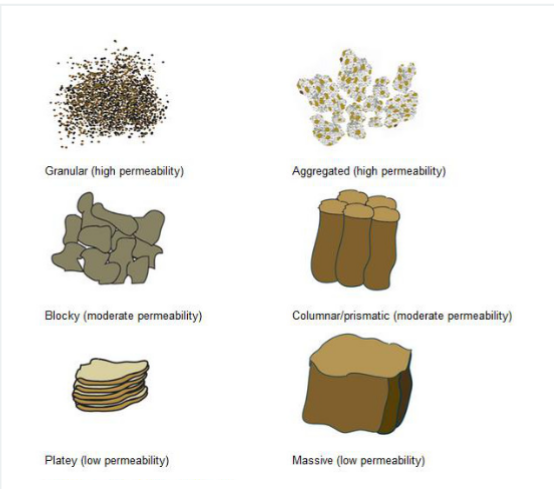
NOTE: There are other types of soil structures apart from the above.
DESCRIPTION OF THE TYPES OF SOIL STRUCTURES
1. ALVEOLAR: This is an abundant circular, honeycomb type of soil particle arrangement. It has void pore phases. It may not be easily recognized in the field.
2. ANGULAR BLOCKY: It is a ped with sharp angular corners with flat, convex and/or concave faces and cube-like. The are usually firm or hard and tightly packed together.
3. BRIDGE: This is a fine material with bridging single grains
4. CHANNELS: This is an abundant intertwining channels containing varying amount of worm faecal matter.
5. COLUMNAR: They are large, vertically, rectangular, elongated peds. It has three or more vertical faces with rounded top. The peds may be composed of smaller peds. They are distinctive middle horizons of many Solonetz and Solodic Planosols.
6. COMPOSITES: They are combinations of many of the other types of aggregates.
7. COMPOUND: These are large peds such as prisms or columns that are themselves composed of smaller incomplete peds.
8. CRUMB: They are irregularly shaped peds with rough surfaces and forming a loose porous mass. It has round surfaces but larger than granular. They are common in the upper horizons of grassland.
9. GRANULAR: These are subspherical peds usually form a fairly loose porous mass. It has round surfaces. It is found at the soil upper horizon.
10. IRREGULAR BLOCKY: These are irregular shaped peds with flat concave and /or convex faces. It has a mixed rounded and angular corners.
11. LARBRYINTINE: They have intertwined fauna passage containing varying amount of granular materials. They are formed by termite. They are mostly found in the upper horizon of tropical soil.
12. LAMINAR : They are horizontally elongated peds with flat parallel surface.
13. LENTICULAR: These are lens shaped peds with convex surface. They overlap each other and are commonly found in each horizons that has being frozen or compacted by implements.
14. MASSIVE OR COHERENT: They are continuous soil phase without peds. They are found at the lower horizons or underlying materials.
15. PLATY : These are soils made up particles aggregated in thin plates or sheets, piled horizontally on one another. Plates often overlap, greatly impairing water circulation. It is commonly found in forest soils, in part of the A- horizon, and in clay pan soils.
16. PRISMATIC: They are vertically elongated peds with three or more vertical faces and flattened top . The peds often have an indeterminate upper and lower boundaries. This structure is commonly found in medium and fine soil texture.
17. SINGLE GRAIN : No aggregates, individual detrital grains. They are small rock fragments and are common in leached horizons.
18. SUBANGULAR BLOCKY: These are peds with convex and/or concave faces. They are cube-like with flattened surfaces and also have rounded corners. They are found at the middle horizons.
Others include spongy, subcuboidals, vermicular, and wedge.
Structure is the least permanent property of soil. It can be altered very rapidly by cultivation, or any type of soil disturbance.
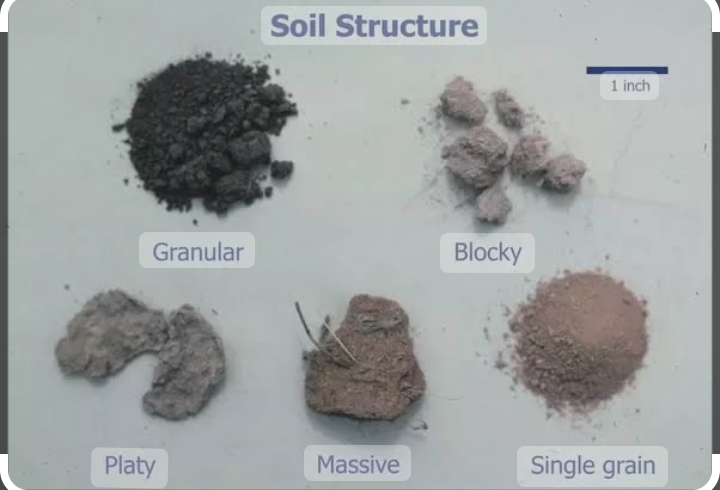
MECHANISMS OF SOIL AGGREGATION
Soil structure are cemented or bound together by physical, chemical, and biological processes.
1. Soil microorganisms like fungi and bacteria excrete substances that act as cementing agents and bind soil particles together.
2. Fungi have filaments, called hyphae, which extend into the soil and tie soil particles together.
3. Roots also excrete sugars into the soil that help bind minerals.
4. Oxides also act as glue and join particles together. This aggregation process is very common to many highly weathered tropical soils and is especially prevalent in Hawaii.
5. Finally, soil particles may naturally be attracted one to another through electrostatic forces, much like the attraction between hair and a balloon.
PROCESSES THAT AID THE FORMATION OF AGGREGATES
1) wetting and drying.
2) freezing and thawing,
3) microbial activity that aids in the decay of
organic matter,.
4) activity of roots and soil animals.
5) adsorbed cations.
6) Application of organic fertilisers
7) Crop rotation practices
8) Afforestation and revegetation
1&2 : SOIL FORMATION FACTOR : All of the soil-forming factors, especially climate, influence the type of structure that develops at each depth. The climate which brings about wetting/drying and freezing/thawing action in pushing particles back and forth to form aggregates.
Also, as roots grows, they absorb water and dry the soil causing cracks to form along planes of weakness. when the roots decay, root channels serve as conduits for water that facilitate wetting/drying and freezing/thawing.
3 MICROBIAL ACTIVITY THAT AIDS IN THE DECAY OF ORGANIC MATTER : This is a Biological processes that build soil structure. Soil microbs act to decompose animal remains and plant residues to produce humus and organic glues. The Decayed plant residues and microbial byproducts coat soil particles and bind particles into aggregates. The humus and the organic glues cement together the Soil particles during decomposing of the organic matter. Example of such glue is glycoprotein glomalin.
4) ACTIVITY OF ROOTS AND SOIL ANIMALS : Aggregation is promoted by root growth. Plant roots excrete polymers and sugars which microorganisms feed on and also helps bind soil particles together. Soil particles are pushed closer together by roots as they push through the soil and grow in length and width and the soil animals as they burrow into the soil.
5) ADSORBED CATIONS : This is a chemical processes that build soil structure. The adsorbed cations help form aggregates whenever a cation is bonded to two or more particles. For example, Polyvalent cations like Ca2+, magnesium Mg2+, and aluminum Al3+ bind together clay particles
6. APPLICATION OF ORGANIC FERTILIZERS: Organic material in the form of crop residue, animal manure, sludge, and green manure may be added to soil to improve the structure. These materials are usually applied to the surface of the soil and are critical to the development of granular and crumb structure. As organic material is incorporated by tillage, soil animals and microorganisms, it aids in subsoil structure development.
Also, addition of biochar may increase aggregate stability, retention of soil water and enhance microbiota activity. All together, both biochar and organic materials have positive effects on soil porosity, available water content, infiltration, soil aggregation, and bulk density.
7. CROP ROTATION PRACTICES: The incorporation of shallow rooted crops with deep rooted crops in crop rotation helps improve soil structure. The choice of crops with different root biomass production and rooting depth is essential for improving soil structure. Thus, deep-rooted crops should be planted with shallow-rooted crops to preserve soil structure
8. AFFORESTATION AND REVEGETATION: Afforestation of sites with degraded soils assists in the development of soil structure within the bounds set by soil texture and climate. Litters from forest trees build up at rapid rate on forest floors forming organic matter accumulation which aid aggregate formation and development.
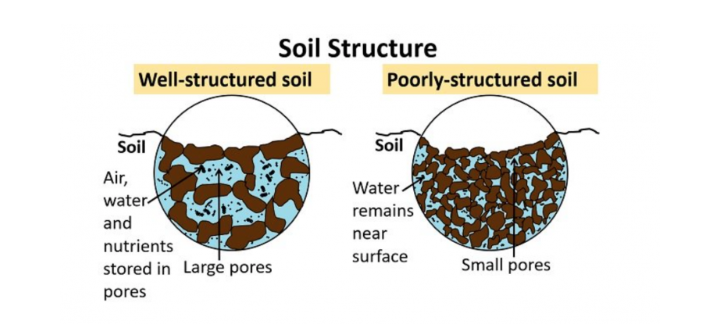
IMPORTANCE OF SOIL STRUCTURE
Aggregates are important in a soil because
1. They influence bulk density, porosity and pore size.
2. Pores within an aggregate are quite small as compared to the pores between aggregates and between single soil particles. This balance of large and small pores provides for good soil aeration, permeability and water-holding capacity.
3. Soil aggregation is an important indicator of the workability of the soil.
4. Soils that are well aggregated are said to have “good soil tilth.”
5. Good soil structure makes soil to be resistant to soil erosion and compaction.
6. A strong soil structure can provide sufficient water, nutrients, and oxygen to support plant growth and enough space for roots to penetrate, while poor soil structure impedes root growth, water movement and drainage.
FACTORS THAT DISTROY SOIL STRUCTURE
Soil structure can be lost through land use practices that reduce organic matter inputs, lower the abundance of roots and soil organisms, or compact the soil. Poor soil structure is a common characteristic of soils in arid and semiarid regions, which contributes to their high susceptibility to erosion.
When soil structure is destroyed, soil degradation occur, thus leading to issues such as crusting, compaction, anaerobiosis, erosion, reduced CEC, loss of fertility, and desertification.
The following factors are responsible for soil structure distruction: Tillage, falling raindrops and compaction are primarily responsible for destroying aggregates. Other factors include Removal of vegetation, excessive moving and handling of soil, screening, excessive sodium, deforestation, overgrazing, bare fallows, applications of fungicides and insecticides, and substitution of organic fertilizers with chemical fertilizers.
1. TILLAGE: Tillage implements include: plough, Harrow, ridger, cultivators, etc. which are driven by tractors for land preparation. As the cutting edge of a tillage implement is pulled through the soil, the shearing action at the point of contact breaks apart aggregates. If tillage is conducted at the same depth for several years, a tillage pan may develop. This is one form of compaction. Particles of the aggregates may break off and reorganize themselves to form another type of structure mostly platy structures. The amount of aggregate destruction that results from tillage depends on the amount of energy the tillage implement places in the soil. The field cultivator has little down pressure and destroys few aggregates. The disk, however, has both cutting action because of the rotation of the disk and shearing action. Together there is substantial down pressure and destruction.
2. ACTION OF RAIN DROPS: The continuous impact of raindrops hitting the ground during heavy rainfall can dislodging soil particles and “splashing” them up. Aggregates on the soil surface are broken down by the beating action of raindrops. The splashed particles clog soil pores, sealing off the soil surface and leading to poor water infiltration. Single particles that were once part of the aggregate can easily form a crust when the soil dries. The sealed soil surfaces and pores makes it difficult for water to infiltrate a crust and for seedlings to push up through the crust. The particles also can be eroded if they become detached by rainfall.
3. COMPACTION: Compaction can lead to the breakdown of aggregates in the surface soil and subsoil if the applied force from wheel traffic, animal traffic or human traffic is greater than the force holding an aggregate together. Heavy machines usage is the major cause of soil compaction. This leads to granular structure on the soil surface to break down and reform as blocky structure and blocky or subangular blocky structure in the subsoil become structureless. Lots of platy structures are also formed on the soil surface with pore spaces sealed up.
4. EXCESSIVE SODIUM : Excess sodium in soil can degrade soil structure, slow infiltration rate and interfere with uptake of calcium, magnesium and potassium. When the ratio of sodium to calcium and magnesium ( that is, high proportion of sodium) is high, clay particles will repel each other when wet, so aggregates are dispersed, and the process of soil structure formation is reversed. Soils with too much sodium become almost impermeable to water because the dispersed clay and small organic particles clog up remaining soil pores. Excessively high sodium levels can result from irrigation, sodium containing fertilizers and salinization.
6. DEFORESTATION: The effects of tree loss on soil are significant. Trees and shrubs shield the ground from the force of raindrops and provide shade that reduces surface soil temperature, which in turn reduces evaporation. Also, forest trees and shrubs are good sources of organic material build up that can improve soil structure development. Logging and small-scale removal of trees exposes soil to rain splash which loosens and dislodges soil particles, eroding soil and creating a more impermeable bare surface, which increases runoff.
5. SUBSTITUTION OF ORGANIC FERTILISERS WITH CHEMICAL FERTILISERS
Inorganic fertilizers can cause soil degradation especially when it is overused. It can cause soil acidification and soil crust thereby reducing organic matter content, humus content, beneficial soil organisms, change soil pH, and inhibit crop growth. Organic materials, exudates produced by plant roots and excrement of soil organisms act as cementing agents for soil particles. When they are reduced by over use of chemicals fertilizers, soil structure is distroyed.
If soils are low in organic matter, soil structure can be encouraged by application of exogenous organic matter such as compost, manure, or municipal waste (sewage sludge, garden, and municipal solid waste). Applications of organic wastes to degraded soils have been shown to reduce bulk density and increase plant-available water, infiltration rates, nutrient supply, microbial biomass, extracellular enzyme activity, aggregation, and aggregate stability.
AGGREGATE STABILITY
Stable soil aggregation is very important in productive soils. The stability of soil aggregation is very reliant on the type of minerals present in the soil. Certain clay minerals form very stable aggregates, while other clay minerals form weak aggregates that fall apart very easily. Soil texture, soil parent material, soil organic matter, and disturbance all influence soil aggregate stability.
Highly weathered silicate clays, oxides, and amorphous volcanic materials tend to form the most stable aggregates. The presence of organic matter with these materials improves stable aggregate formation. In nutrient management, the aggregate stability is important because well-aggregated minerals are well drained and quite workable.
In contrast, less weathered silicate clays, such as 2:1 clay minerals like montmorillonite, form weak aggregates. Some silicate clays are said to have a shrink-swell potential. This means that the soil minerals expand, or swell, when wet, causing the soil to become sticky and drain poorly. When dry, these soils shrink and form cracks. The make-up of the lattice structure of silicate clays determines the shrink-swell potential.
